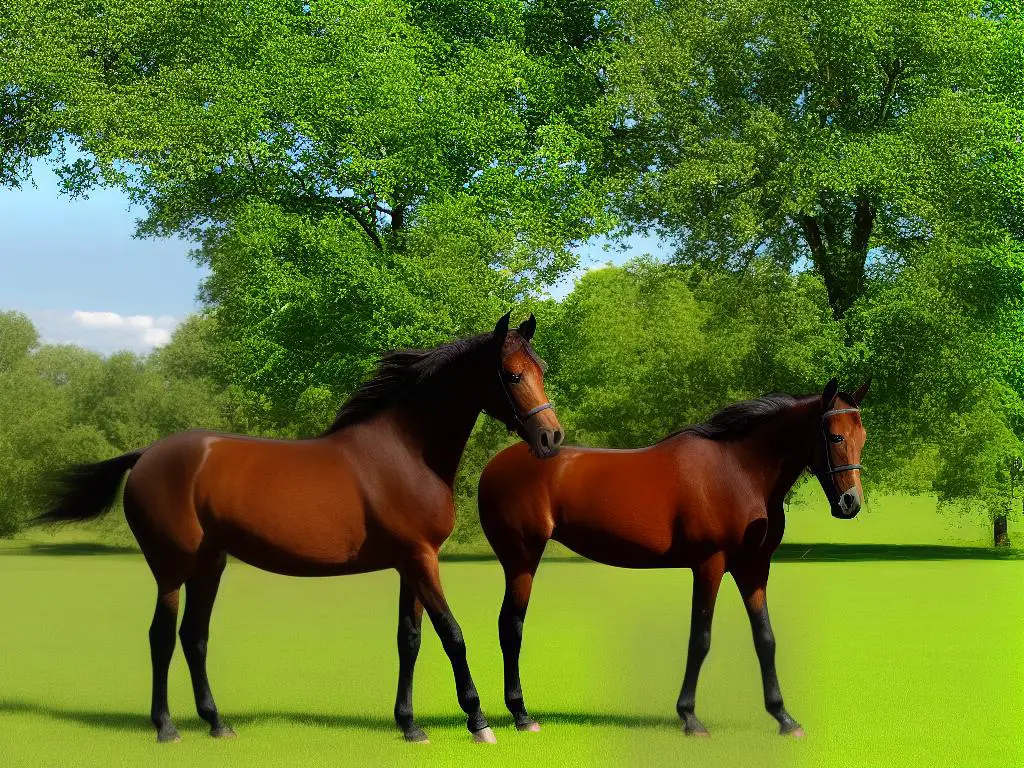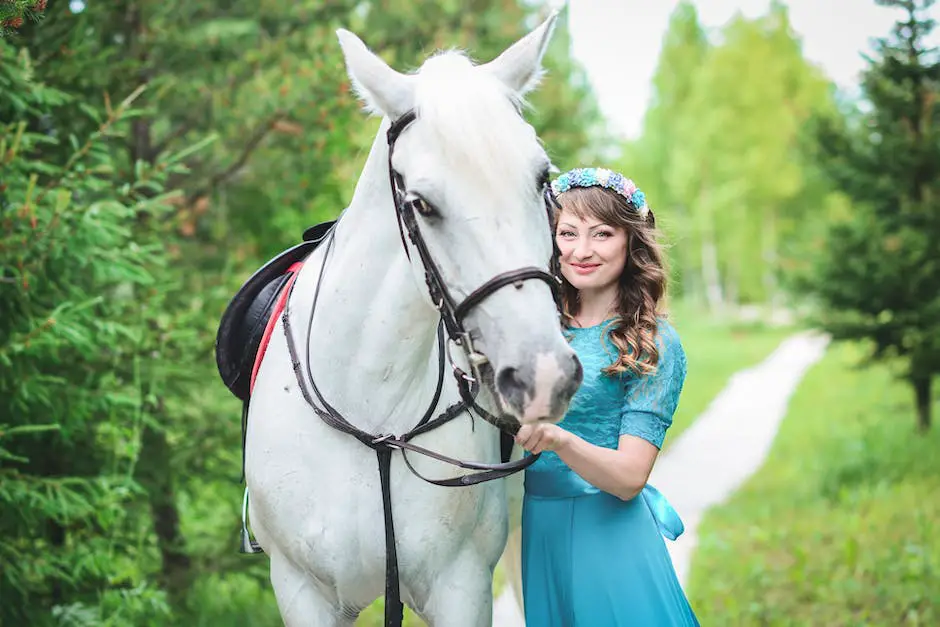As an enthusiast or hobbyist looking to delve into the world of Saddlebred horse sales, understanding the breed’s rich history, unique characteristics, and various aspects of the buying and selling process is essential. In this article, we will explore the origins and development of Saddlebred horses, their distinct traits, and the necessary knowledge and skills needed to successfully navigate this niche market.
Table of Contents (Horspedia)
History of Saddlebred Horses
The Saddlebred horse, also known as the ‘”American Saddlebred,” is a breed that traces its origins to the early colonial days of America. This breed is the result of a combination of several other breeds, including the Thoroughbred, the Morgan, the Narragansett Pacer, and the now-extinct Hobbie horse.In the 19th century, Saddlebreds played a crucial role in the development of American horse culture. Known for their high-stepping gait and natural grace, these horses became highly sought after by plantation owners in the South, who often held competitions to display their horse’s talents. These early competitions laid the groundwork for the booming Saddlebred horse sales and show industry that would develop in the late 19th and early 20th centuries. In fact, it was during this time that the American Saddlebred Horse Association, the oldest American breed registry, was established to promote these horses and maintain their unique qualities.Saddlebred horse sales are thriving in today’s market, drawing enthusiasts and hobbyists from across the nation and beyond. Central to the breed’s ongoing growth and popularity, Saddlebred auctions offer a wide variety of horses for buyers to select from, such as show ring contenders, broodmares, and experienced champions. As more people become aware of this unique breed, the Saddlebred horse market remains robust, reflecting the rich history and enduring allure of these captivating animals.

Saddlebred Horse Characteristics
The American Saddlebred horse stands out for its remarkable beauty, grace, and athleticism, making it one of the most in-demand breeds in the equestrian world. Featuring a refined head with large, expressive eyes and a long, elegant neck, the Saddlebred presents an unmistakable, captivating appearance. Their well-muscled, proportionate bodies boast powerful shoulders and quarters that enable fluid, effortless movement. Ranging between 15 and 17 hands tall and sporting a variety of coat colors, Saddlebred horses showcase both visual appeal and strength. This exceptional blend of beauty and power attract numerous enthusiasts and hobbyists to this highly desirable breed.Equally as impressive as their physical traits is the Saddlebred’s vibrant and engaging temperament. Known for their intelligence and eagerness to please, these horses are highly trainable and versatile, making them suitable for a wide range of disciplines. They possess a natural athleticism and showmanship, enabling them to excel in competitive events such as saddle seat, driving, and dressage. Saddlebreds have a long history of being bred for their pleasing personalities; therefore, potential buyers can be confident in the good-natured disposition these horses possess. As a result, Saddlebred horse sales often fetch premium prices due to their winning combination of appearance, athleticism, and character.Saddlebred horses are renowned for their distinctive movements that make them stand apart from other horse breeds. Their smooth and lofty gaits consist of high-stepping, animated motions that are a delight to witness and experience. The five gaits showcased by these horses are the walk, trot, canter, as well as two unique four-beat gaits called the slow gait and the rack. The slow gait is a highly-collected, rhythmic movement, while the rack is a more rapid, ground-covering stride. Often referred to as the “peacock of the horse show world,” Saddlebred horses captivate riders and spectators alike with their eye-catching, show-stopping performances. This unparalleled ability to exhibit these extra gaits, combined with the breed’s striking beauty and remarkable temperament, makes Saddlebred horses extremely desirable and valuable in the realm of horse sales.

Buying and Selling Saddlebreds: Basics
There are several crucial factors to keep in mind when buying or selling Saddlebred horses to ensure a successful deal. It is vital to extensively research and comprehend the Saddlebred breed, its unique features, and typical applications before determining whether this breed is the right match for you, as a buyer or seller. The American Saddlebred is a versatile and elegant breed, often associated with three- and five-gaited show classes. Furthermore, they are used in driving, hunting, and equitation, making their potential uses and skill levels important aspects to consider when evaluating a Saddlebred horse during the sales process.
One core aspect of buying or selling Saddlebreds is understanding the factors that contribute to the pricing. Factors such as age, health, training, bloodlines, and show records play a significant role in determining a horse’s value. The Saddlebred’s pedigree can provide valuable information about the horse’s lineage, potential abilities, and genetic strengths or weaknesses. When evaluating a Saddlebred, it is crucial to consider vet checks and health evaluations to ensure the horse is in good health and condition. Additionally, buyers should take time to observe the horse’s temperament, gait, and conformation to ensure a suitable match.
When approaching Saddlebred horse sales, it’s crucial for buyers to consider the various purchasing methods such as private sales, auctions, or connecting with professional trainers or breeders. Each method has its advantages and potential drawbacks: private sales often provide buyers with more time to evaluate a potential purchase, while auctions can offer a wider selection of horses. Regardless of the chosen method, establishing connections with knowledgeable individuals within the Saddlebred community is essential for staying informed about current market trends and reputable sources for buying or selling. By being diligent in research and staying well-informed, enthusiasts can ensure a successful and enjoyable experience in Saddlebred horse sales.

Preparing a Saddlebred for Sale
Taking proper care of a Saddlebred horse before the sales is essential in maintaining an optimum physical condition. To achieve this, it’s important to provide daily grooming, exercise, and a well-balanced diet that maintains the horse’s ideal weight and appearance. Regular grooming not only enhances the horse’s physical appearance but also helps in identifying and addressing any minor health issues such as skin irritations or injuries. Exercise routines should cater to the horse’s particular needs, combining strengthening, conditioning, and flexibility exercises for holistic fitness. Besides focusing on physical wellbeing, it’s crucial to create a stress-free environment to maintain the horse’s calm demeanor, a desirable trait often sought by potential buyers.
A critical factor in preparing a Saddlebred for sale is solidifying their training and refining their skills in riding, gait transitions, and general ground manners. Saddlebreds are known for their versatility in various disciplines, including saddle seat, dressage, and jumping. Therefore, it’s crucial to showcase their abilities in these areas to attract potential buyers. Additionally, emphasizing appropriate ground handling manners, such as leading, tying, and loading into a trailer, will make the horse even more appealing to prospective clients. Consider enlisting the help of a professional trainer or taking part in clinics to polish your horse’s skills and improve your sales prospects.
Preparing your Saddlebred horse for sale involves ensuring its health and veterinary care are up to date, including routine vaccinations, dental care, and deworming, as well as addressing any underlying health issues that may deter potential buyers. Providing buyers with a comprehensive health record and necessary certifications, such as a negative Coggins test, can instill confidence in the horse’s overall health and wellbeing. Additionally, consider having a pre-purchase examination performed by a reputable veterinarian to identify and address any potential concerns before the horse is presented for sale. This proactive approach demonstrates transparency and integrity and is likely to result in a more successful sales experience.

Selecting the Right Saddlebred
Once you have prepared your Saddlebred horse for sale, it is important for buyers to select the right horse that suits their needs by considering several important factors such as intended use, bloodlines, and overall quality. Saddlebreds are versatile and excel in various disciplines such as show, pleasure, or breeding. As a seller, it is essential to communicate what the horse is best suited for and to provide comprehensive information about the attributes that make it an ideal candidate for specific roles. By combining the preparation of your horse with a well-informed description of its attributes and possible uses, this will help build a smooth and successful sales experience for both parties involved.
Bloodlines play a significant role in the selection process, as they can provide useful insights into the horse’s potential, temperament, and ability to perform. Spend some time researching the pedigrees of successful Saddlebred horses in your desired discipline to familiarize yourself with the lineage and characteristics associated with top-performing horses. This background knowledge will prove invaluable when visiting sales and speaking with sellers about the horse’s ancestry.
Developing skills in assessing Saddlebred horses is crucial for enthusiasts or hobbyists aiming to become proficient in sales. This involves careful examination of the horse’s overall quality, including conformation, athleticism, and movement. Key areas to consider are the head, neck, shoulders, back, and hindquarters. Equally important is the evaluation of the horse’s temperament and work ethic, which can provide valuable insights into its performance and compatibility with the rider’s program. Observing the horse in motion, both at liberty and while ridden (if possible), is essential for acquiring an accurate understanding of its overall quality. Consulting experienced Saddlebred professionals or trainers while assessing these factors will help buyers make well-informed decisions when selecting their ideal Saddlebred horse.

Saddlebred Auctions and Sales Events
The Saddlebred horse sales market offers a diverse range of options, catering to individuals with varying preferences and budgets in the equestrian community. Sales can be found in the form of private offerings or structured auctions where potential buyers gather in search of their perfect Saddlebred partner. This seamless connection from careful evaluation of the horses to the sale events further emphasizes the importance of developing expertise in assessing Saddlebred horses. By mastering these crucial skills, both buyers and sellers alike can ensure a successful and enjoyable experience in the Saddlebred horse sales journey.
In private sales, buyers often work with breeders or potential sellers to find the right match through personal connections or online advertisements. On the other hand, auctions are larger events that usually showcase a wide variety of horses, offering enthusiasts the opportunity to observe and bid on a plethora of prospects.
Auctions and sales events usually host horses of diverse backgrounds, including proven show horses, young prospects, and horses suited for breeding. Prospective buyers must-have knowledge about the specific lineage, quality of the horse, and its potential application, such as riding, driving, or showing, before attending these events.
To better understand and become skilled in these events, enthusiasts and hobbyists should network with seasoned sellers and trainers to learn more about different horses’ specific characteristics and tendencies. Doing this, coupled with time spent carefully observing the horse’s behavior and conformation and seeking expert opinions, will vastly improve the chances of finding a suitable Saddlebred.
Passionate about the unique Saddlebred breed, enthusiasts and hobbyists in the world of Saddlebred horse sales are dedicated to the industry’s continued success. It is crucial to thoroughly research a horse’s competition background, registration, and medical history prior to any purchase, whether through a private sale or an auction. Exercising due diligence is essential to avoid scams or unsuitable horses, and developing skills in the art of Saddlebred horse sales requires patience, knowledge, intuition, and networking. The end goal is to acquire a valuable and well-suited equine partner as a result of these efforts.

Completing the Sale: Contracts and Paperwork
When finalizing a Saddlebred horse sale, it is essential to properly address and execute all necessary documentation, contracts, and legal aspects. Both the buyer and the seller must have a clear understanding of the sale’s terms and conditions, and each party must comply with the specific laws and regulations governing equine transactions in their respective jurisdictions. Making use of well-drafted contracts ensures that both parties are aware of their rights, responsibilities, and any warranties or guarantees related to the horse being sold, ultimately connecting the process smoothly and safeguarding the interests of everyone involved.
In a Saddlebred horse sale, the primary documents that must be prepared and executed include the bill of sale, registration papers, and any health or veterinary records. The bill of sale is a legally binding document that confirms the transfer of ownership of the horse from the seller to the buyer, and it should contain a detailed description of the horse, the purchase price, the terms of the payment, and any representations or warranties made by either party. Registration papers should also be updated and transferred to the new owner, according to the requirements of the breed registry, the American Saddlebred Horse Association.Another critical aspect of finalizing a Saddlebred horse sale is addressing any potential liabilities or disputes that may arise after the transaction. This might include issues related to the horse’s health, undisclosed defects or vices, or disputes over payment or ownership terms. To minimize the risk of such issues, both parties should consult with experienced equine attorneys and obtain all necessary pre-purchase examinations, such as a veterinarian’s health certificates or performance evaluations. Carefully reviewing and drafting the terms of the sale agreement can help prevent misunderstandings and provide both the buyer and the seller with clearer expectations and a more enjoyable and rewarding experience in the world of Saddlebred horse sales.

Armed with the information provided in this article, both new and experienced Saddlebred horse enthusiasts can better understand the complexities involved in buying and selling these exceptional animals. From selecting the ideal horse based on intended use and lineage, to preparing for sales events and ensuring a smooth and legally sound transaction, the insights shared will help you make informed decisions and fully appreciate the beauty and distinctive qualities of Saddlebred horses. Enjoy your journey and best of luck in your Saddlebred horse experiences!